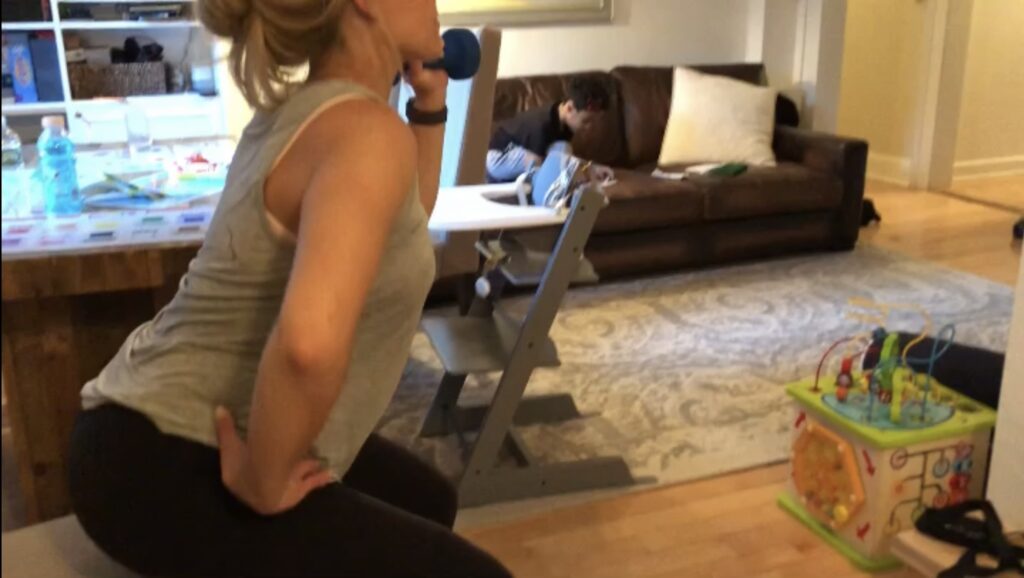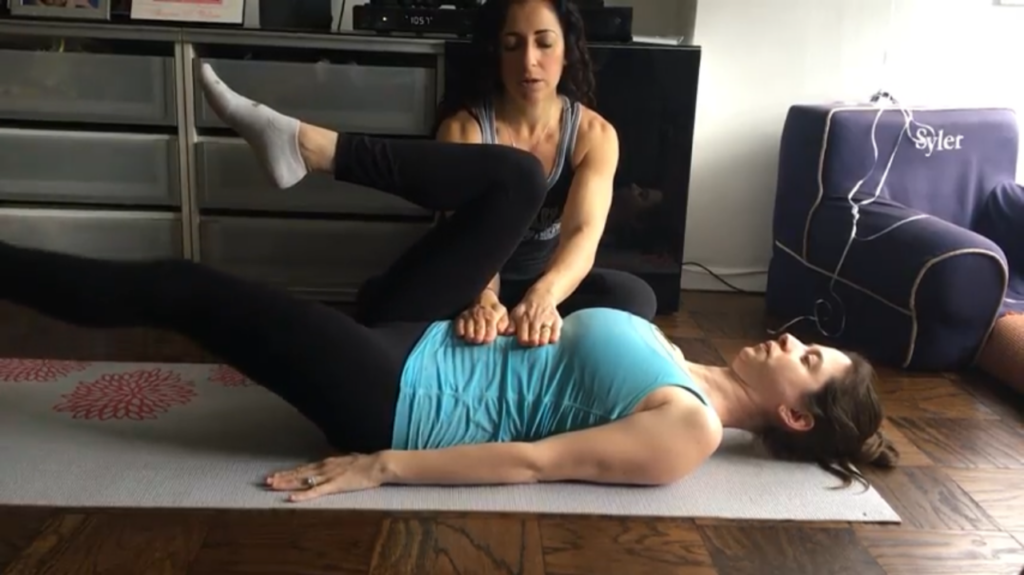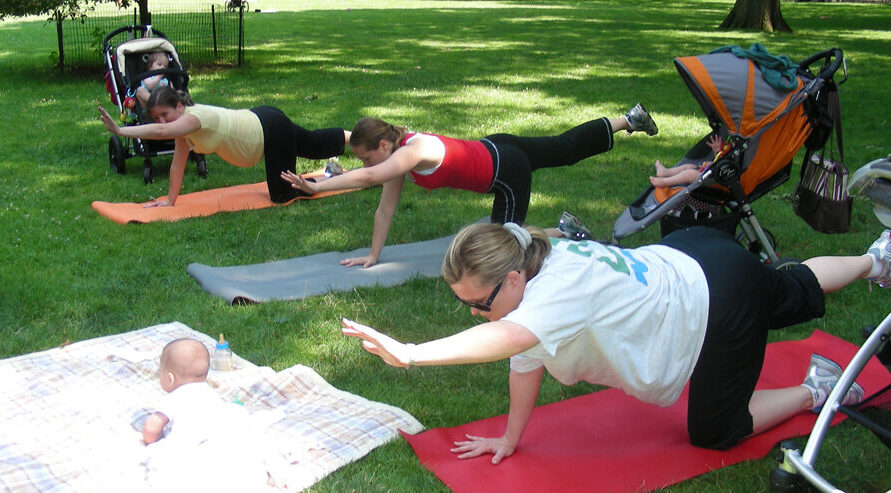Looking to tone, strengthen or tighten your midsection?
A new mom or getting ready to have another child?
Suffering from back pain or poor posture?
Frustrated that you can’t seem to flatten your tummy?
Planning on getting pregnant or already pregnant?
20+ years postpartum?
Then you’re in the right place.
The term “diastasis recti” refers to the separation of the outermost layer of the abdominal muscles, the rectus abdominis, or recti (what we commonly refer to as the “six pack”). The recti muscles are a pair of muscles that are joined together by connective tissue called the linea alba. During pregnancy, the pressure of the expanding uterus pushing against the abdominal wall causes this connective tissue to stretch laterally, thereby causing the recti to spread apart.

There is a LOT of incorrect information out there about diastasis recti, including the notion that the muscles have “torn.” The truth is, our bodies have connective tissue running down the center of our abdomen so that the stretching and expansion that need to happen during pregnancy can happen, without any tearing or damage to the muscles. Having diastasis recti, in and of itself, is not something to worry about, as long as women understand how to avoid making the condition worse, and are properly educated about how to safely exercise. Without a clear understanding of how to workout and go through every-day activities safely, it is very easy to make a diastasis larger, weaken the core, and suffer injuries as a result.
While this is the most effective way to test yourself for a diastasis, it is not something that should be done frequently. Laying on your back and lifting your head and shoulders with your stomach muscles relaxed is what enables you to determine the severity of your separation. But because your stomach muscles are opening every time you do this, it certainly is not helping to improve your diastasis or strengthen your core. The reality is, if a woman ever carried a child, she likely has a diastasis, and the way to treat the condition remains the same regardless of how large the separation is.
Pregnant women can check themselves for a diastasis the same way non-pregnant women can, although women who are 20 weeks pregnant or more should lay on an inclined surface rather than flat on their backs. It may be hard to feel any separation in any or all of the three testing sites depending on how far along the woman is, and the position of the baby. If a pregnant woman ever sees “coning,” or a vertical bulge running down her abdomen, this is a clear indication of diastasis recti, and a warning that too much strain is being placed on the abdominal wall. Whatever position the woman is in, or whatever activity she is doing while seeing this coning, it needs to be modified so the bulging does not happen.
Because diastasis recti is something that occurs naturally, it really cannot be prevented. The good news, though, is that it can be minimized, and you can prevent it from causing problems as you progress through pregnancy and motherhood. The only way to do this is to learn how to properly engage the core, work on exercises that build strength in the deep core muscles, and ensure that your daily activities and workouts are done in a way that avoids placing additional pressure on your abdominal wall.
So how do you do that? Here is a very simple example: Cover your stomach with your hands, keep your muscles relaxed, and cough. Notice how your belly moves. Now try to draw your stomach in towards your spine, away from your hands, and keep it there without holding your breath or raising your shoulders. Now cough with the same force. Hopefully this time when you coughed, you noticed less pressure pushing onto your hands.
Learning how to properly engage and use your core goes far beyond keeping your stomach drawn in while you cough, but this example demonstrates how easy it can be to prevent forceful pressure on your abdominal wall when you focus on it.
Proper core engagement takes time and practice to understand and master. To engage your core, you must engage your transverse abdominis muscle, the deepest layer of your abdominal muscles. This muscle wraps around your body like a corset.
First, imagine “wrapping” your torso to “cinch” your waist. The easiest way to explain this is to place your hands on your back, on either side of your spine. Slowly drag your hands from your back, around your sides and towards the front of your stomach. You are effectively “tracing” your transverse muscle as you do this. As you slide your hands from your back, around your sides, and towards the front of your stomach, visualize your transverse muscle engaging and doing the work to draw your waist in.
Second, draw your entire belly in towards your spine, without holding your breath or raising your shoulders. It’s not just a matter of “sucking in” or “pulling belly button to the spine.” Instead, picture your upper abs (the area above your belly button), your middle abs (belly button area), and lower abs (the area under your belly button), all drawing up and in towards your spine, but make sure you are not restricting your breath or tensing your upper body while doing this.
With time and practice, “engaging the core” becomes a natural, almost automatic maneuver that will not require your hands on your torso.
Diastasis recti affects everyone differently. Some women will go through their whole lives not ever knowing they had any separation between their stomach muscles. Others can experience a wide range of problems. Some women struggle with the appearance of their stomach, regardless of how much they exercise or how well they eat. A distended, pregnant-looking belly is a very common occurrence in women with diastasis recti, especially those who are on the smaller side. Some women will suffer from pelvic floor dysfunction, including a lack of control over their pee, which can happen during or following pregnancy, or later in life. Other problems that can result from diastasis recti and a weakened core include back problems, sacroiliac (SI) joint issues, hernias, pelvic pain and fractures, and in extreme cases, organ prolapse.
There are many factors that contribute to how much, if at all, a diastasis will close following a pregnancy. The reality is that once a separation exists, it will never close completely. For that reason, with subsequent pregnancies, the diastasis will still exist, but that doesn’t necessarily mean it will be larger or more problematic than it was before. To the contrary, a diastasis during a second or third pregnancy can actually be smaller than it was during an earlier pregnancy, and also can cause fewer problems for the mother the second or third time around. The outcome depends on how successful the woman is in avoiding damaging movements and keeping her core properly engaged during strenuous activities, and how much effort she puts into proper core strengthening during and following her pregnancies.

Access to a prenatal and postpartum exercise library that teaches you everything you need to know to strengthen your core, improve a diastasis, and get your entire body stronger than ever so you can safely do any workout you desire.

Working around your schedule with whatever “equipment” you have handy (e.g. cans, baby toys, or furniture), get fun and effective cardio and total body workouts with special emphasis on proper core strengthening techniques.

Working out while pregnant and as a mom can feel impossible at times, but having a group of women sharing similar experiences right there with you can make all the difference.
We can also create customized workout programs just for you.
© Fitnotic 2023. All Rights Reserved. Site by PivotSixtyFive
| Cookie | Duration | Description |
|---|---|---|
| cookielawinfo-checkbox-analytics | 11 months | This cookie is set by GDPR Cookie Consent plugin. The cookie is used to store the user consent for the cookies in the category "Analytics". |
| cookielawinfo-checkbox-functional | 11 months | The cookie is set by GDPR cookie consent to record the user consent for the cookies in the category "Functional". |
| cookielawinfo-checkbox-necessary | 11 months | This cookie is set by GDPR Cookie Consent plugin. The cookies is used to store the user consent for the cookies in the category "Necessary". |
| cookielawinfo-checkbox-others | 11 months | This cookie is set by GDPR Cookie Consent plugin. The cookie is used to store the user consent for the cookies in the category "Other. |
| cookielawinfo-checkbox-performance | 11 months | This cookie is set by GDPR Cookie Consent plugin. The cookie is used to store the user consent for the cookies in the category "Performance". |
| viewed_cookie_policy | 11 months | The cookie is set by the GDPR Cookie Consent plugin and is used to store whether or not user has consented to the use of cookies. It does not store any personal data. |